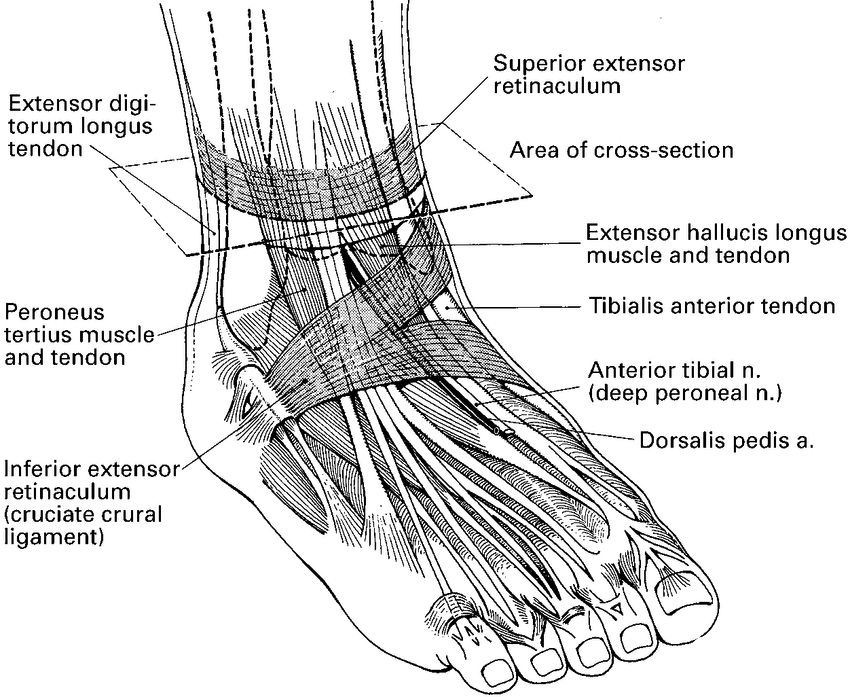Ankle Sprains and Ligament Injuries
What Is an Ankle Ligament Injury?
Ankle Ligament Injuries are also referred to as Ankle Sprains. They are caused by direct or indirect trauma to the ankle ligaments.
A sprain can occur when the ligament is stretching beyond its normal range of motion
An ankle sprain is a common and often a painful injury that occurs when you suddenly fall or twist the joint or when you land your foot in an awkward position after a jump.
Ankle Tendons vs Ligaments
Tendons and ligaments are thick bands of tissue comprising collagen. They both help stabilize the body joints, structures and facilitate body movements.
The main difference between tendons and ligaments is that they connect different parts of the anatomy.
- Tendons connect muscles to bones,
- Ligaments connect bones to other bones.
An ankle strain is an injury that occurs when ankle muscles and/or their connecting tendons are either stretched beyond their normal limits or torn outright. Strains may be acute or chronic.
The muscular injury often occurs at the point where the muscle connects to a tendon and may be a side effect of or coexist with Ankle Tendonitis, which is the acute inflammation of one or more tendons in the ankle.
Who are at Higher Risks of Ankle Ligament Injuries?
Ankle ligament injuries can affect people of all ages but Ankle Injuries are more common in some due to lifestyle issues including:
- Poor Sports Preparation - when undertaking strenuous activities without a routine of ankle and calf stretching, strengthening exercises or warm ups
- Muscle and Ligament Fatigue - near the end of a vigorous activity with an elevated "push through" mind set
- Excess Weight - places greater impact load onto the joints
- Females Over 30 - studies indicate increased risks for athletes
- Inappropriate Footwear - footwear such as high-heeled shoes or sports footwear
- Prior Sprains - people with prior history of sprains
How Does Ankle Ligament Injury Affect Your Body?
The complexity of the ankle's muscular and ligament structure creates many possible opportunities for injuries when the ankle is pushed beyond its normal range of motion.
The foot and ankle consists of several ligaments these include
- Anterior talofibular ligament (ATFL), connects the front of the talus bone to a long bone in the lower leg called the fibula
- Calcaneofibular ligament (CFL), connects the calcaneus, or heel bone, to the fibula
- Posterior talofibular ligament (PTFL), connects the rear of the talus bone to the fibula
- Deltoid ligament, a thick ligament which supports the entire medial, or inner, side of the ankle
- Anterior inferior tibiofibular ligament (AITFL), connects the tibia to the fibula
- Posterior fibular ligaments, (two) which crisscross the back of the tibia and fibula:
- The posterior inferior tibiofibular ligament (PITFL)
- The transverse ligament
- Interosseous ligament, which rests between the tibia and fibula and runs the entire length of the tibia and fibula, from the ankle to the knee
The various ligaments that surround the ankle together help form part of the joint capsule, a fluid-filled sac that surrounds and lubricates articulating joints.
What Causes Ankle Sprains?
An Ankle Sprain is caused by local trauma when a ligament is stretched or torn from adjacent bones. Most commonly Ankle Sprains occur when you participate in sports or when you jump or run on a surface that is irregular.
These causes can occur when the ankle is forced beyond its normal range of motion, such as
- twisting when stopping suddenly
- walking/running on an uneven surface,
- landing in an awkward position from jumping
- tripping on an obstacle or irregular surfaces
Inadequate healing of a sprained ligament or incomplete rehabilitation of the affected ligament can result in ongoing ankle instability
Types of Ankle Ligament Injury
Ankle Sprains are categorised based on their severity and depend on the extent of damage to the ligaments.
- Grade 1 - Sprain (mild)
- Minimal stretch with microscopic ligament tear
- Mild swelling and tenderness around the ankle
- Grade 2 - Sprain (moderate)
- Partial ligament tear
- Moderate swelling and tenderness around the ankle
- Abnormal looseness of the joint when manipulated during diagnosis
- Grade 3 - Sprain (severe)
- Complete ligament tear
- Significant tenderness and swelling around the ankle
- Instability when manipulated during diagnosis
Symptoms of Ankle Ligament Injury
Ankle sprains can typically have the following symptoms:
- Pain
- Swelling and Tenderness
- Bruising
- Stiffness
- Numbness in the Toes
- Inability to walk or bear weight on the ankle accompanied by persistent discomfort.
How is an Ankle Ligament Injury Diagnosed?
Patients with Ankle Pain and suspected Ankle Ligament Injury may require a diagnosis that would include:
Medical History
Your doctor will ask questions about:
- Current symptoms and their severity
- If an injury was sustained
- Your medical history including family or genetic links
- Your current and past medications
- The impact of the problem on your occupation and lifestyle
Physical Examination
Your doctor perform comprehensive physical evaluation that will include:
- Examining the affected area for swelling, pain, bruising or other features
- Assessing your range of motion, walking pattern and other relevant features
Diagnostic Testing
Once your doctor has completed the physical examination further tests maybe required. These tests can help your doctor determine or eliminate possible causes. These can include:
- X-Ray
- Ultrasound (US)
- Computerised Tomography (CT)
- Magnetic Resonance Imaging (MRI)
Once a final diagnosis has been completed your doctor can discuss with you and recommend any treatment options.
Non Surgical Treatment for Ankle Ligament Injury
Acute injuries can be managed with conservative treatment measures and can include:
- Rest: Resting the affected area or pausing athletic activity until the symptoms of ankle pain have faded
- Pain medication - Paracetamol or Nonsteroidal anti-inflammatory medications (NSAIDs) can relieve some pain or discomfort
- Acute injuries may require R.I.C.E.
- Rest: Rest the affected area as more damage could result from putting pressure on the injury.
- Ice: Ice should be applied over a towel to the affected area for 15-20 minutes every two to three hours during the day.
- Compression: Wrapping with an elastic bandage or an elasticated tubular bandage can help to minimize the swelling and provide support to the injured area.
- Elevation: Elevating the injured area above heart level will also help with swelling and pain.
- Shoewear: A CAM boot or moon boot is recommended in the initial stages to help support the ankle whilst it is healing
- Physiotherapy: A physiotherapy program focused on restoring balance, strength, range of motion and proprioception is in most cases the best form of treatment to prevent recurrence and return you fastest to physical activity. Your physiotherapist can also tailor your program depending on your type and level of sport.
Surgical Treatment for Ankle Ligament Injury
Surgical intervention to reconstruct the injured ligament may be considered in patients with a high degree of instability and for those who have failed to respond to non-surgical treatments. In these cases your doctor may recommend:
- Ankle Arthroscopy - a minimally invasive surgery where a small camera is used to view the ankle joint and guide miniature instruments to remove fragments of torn ligament, bone or cartilage from within the joint.
- Ankle Ligament Reconstruction - The torn ligament can be surgically reconstructed with sutures or replaced with a graft
What if Ankle Ligament Injury goes Untreated?
Where untreated an ankle ligament Injury can lead to falls and re-injury. Furthermore, recurrent ankle sprains can lead to ankle instability and frequent rolling of the ankle. Recurrent episodes of ankle sprains can lead to joint cartilage damage and arthritis.
Prevention Against Ankle Sprain
An ankle sprain can be prevented by following simple practices:
- Warm up before any exercise and physical activity.
- Walk or run carefully on uneven ground.
- Wear the right kind of shoes.
- Listen to your body and slow down when you feel pain or get tired.








